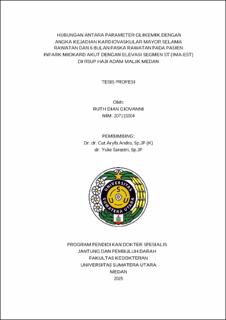| dc.description.abstract | Abstract
Background: Stress hyperglycemia is a condition of transient hyperglycemia in response to an acute condition of disease or stress. Hyperglycemia in myocardial infarction can be caused by increased catecholamine release, steroids, glucagon, and decreased insulin release. Stress induced hyperglycemia is related to worsening outcome in ACS patients and this correlation is more pronounced in non-diabetic patients rather than diabetic ones. Admission blood glucose (ABG), fasting blood glucose, postprandial blood glucose, HbA1c, stress hyperglycemia ratio (SHR), and glycemic gap (GG) are glycemic markers that commonly associated with major adverse cardiovascular events (MACE). The purpose of this study was to determine the relationship between glycemic parameters and MACE in patients with acute myocardial infarction with ST segment elevation at H. Adam Malik Hospital Medan.
Methods: This study was conducted with cross sectional method on 140 patients with acute myocardial infarction with ST segment elevation at H. Adam Malik Hospital Medan who underwent coronary angiography from May 2022 to June 2024. The criteria for acute myocardial infarction with ST segment elevation follows the universal definition of myocardial infarction and follow up for MACE is done during admission until 6 months after discharge. The data were analyzed univariably and bivariate to assess the relationship between glycemic markers and MACE, with p < 0.05 is considered statistically significant.
Results: The total number of study subjects was 140 people, 70 of them are diabetics and another 70 is nondiabetics. Average age in DM group is 56.39 ± 9.19 years and nondiabetics group is 54.54 ± 10.24 years. Most of the subjects were male as many as 117 people (83.57%). MACE is found in 40 patients (57.1%) in DM group and 19 patients (27.1%) in non-DM group. There was a significant relationship between ABG, SHR and GG with MACE, both in diabetics and nondiabetics group (p < 0.001).
Conclusion: There is a significant relationship between ABG, SHR and GG with MACE in patients with acute myocardial infarction with ST segment elevation at H. Adam Malik Hospital, Medan.
Keywords: Glycemic markers, stress hyperglycemia ratio, glycemic gap, MACE, acute myocardial infarction with ST segment elevation | en_US |


